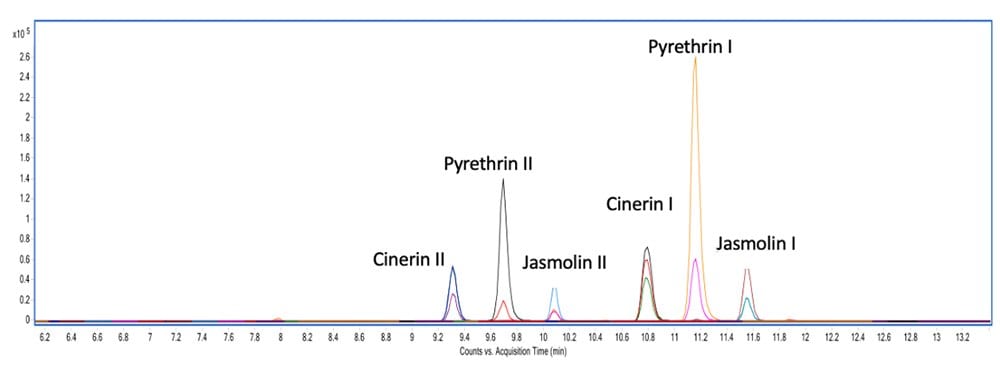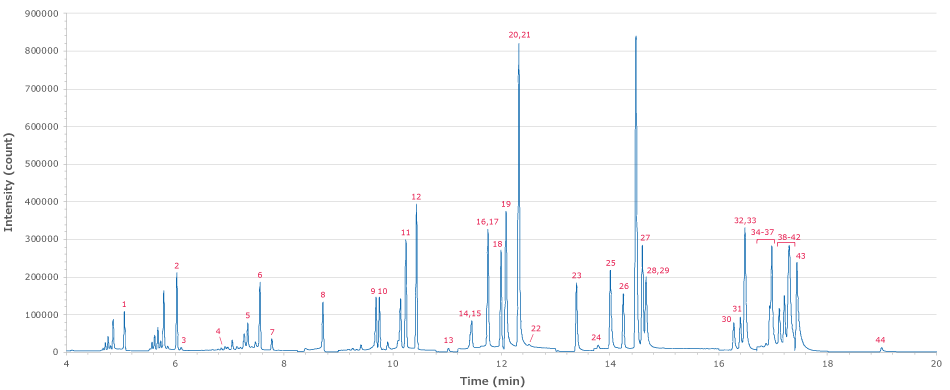Analysis of California Cannabis List of Pesticides, Mycotoxins, and Pyrethrins by LC-MS/MS and GC-MS/MS Using Ascentis® Express Biphenyl and SLB®-5ms Columns
Geoffrey Rule, Ph.D, Principal R&D Scientist, Katherine Stenerson, Product Manager, Cannabis & Pharma QC Reference Materials
Merck
Section Overview
Cannabis Analysis for Pesticides, Mycotoxins, and Pyrethrins
Clinical studies into medical use of cannabis have been limited by availability of federally approved high THC cannabis. Recently, several sites were given approval to produce high THC cannabis products for use in federally funded clinical studies. Not unexpectedly, these sites are also expected to provide high quality cannabis products for use in such studies.
To produce medical quality cannabis products there are a number of attributes necessary to demonstrate quality including potency, purity, and the absence of hazardous contaminants such as heavy metals, mycotoxins, and pesticides.
Here we show chromatography achieved with our Ascentis® Express Biphenyl HPLC column, SLB®-5ms GC column, and our newly developed Certified Reference Material (CRM) mixes for the California pesticide list. For the LC-MS portion of the analysis figures are provided for the five mycotoxin standards, as well as six plant-derived pyrethrins run on the biphenyl column under the same chromatographic conditions. The biphenyl phase was selected for the superior peak shape provided for the analytes of interest. For the GC-amenable pesticides, the SLB®-5ms column was chosen for its low bleed and inertness.

Figure 1.Analysis of 66 California pesticides in CRM mixes (5 ng/µL each compound in acetonitrile/water 70/30 v/v) using Ascentis® Express biphenyl column.

Figure 2.Analysis of five mycotoxins under the same chromatographic conditions. (100 pg/µL Aflatoxin B1 and G1, 30 pg/µL Aflatoxin B2 and G2, and 500 pg/µL for Ochratoxin in acetonitrile/water 70/30 v/v).

Figure 3.Analysis of six pyrethrins (4 ng/µL each in acetonitrile/water 70/30 v/v ) under the same chromatographic conditions.

Figure 4.Analysis of TraceCERT® California pesticide mixes using the SLB®-5ms GC column.
Discussion: Improved Sensitivity and Resolution of Pesticides in Cannabis
Figures 1-4 illustrate chromatographic peak shape and retention times in the LC and GC analysis of the compounds in the TraceCERT® California Pesticide mixes plus five mycotoxins. The Ascentis® Express Biphenyl phase was selected for the LC-MS/MS analysis as it provided the best peak shape for the combination of pesticides, mycotoxins, and pyrethrins. The sharper peaks afforded by the Fused-Core® particle technology of the Ascentis® Express column line provide improved sensitivity and higher resolution for more accurate quantitation of these compounds. For the GC-MS/MS portion of the analysis, the SLB®-5ms was chosen for its low bleed and high inertness characteristics. In addition, use of a FocusLiner™ in the GC inlet ensured minimal adsorption and excellent injection reproducibility.
Related Materials
To continue reading please sign in or create an account.
Don't Have An Account?